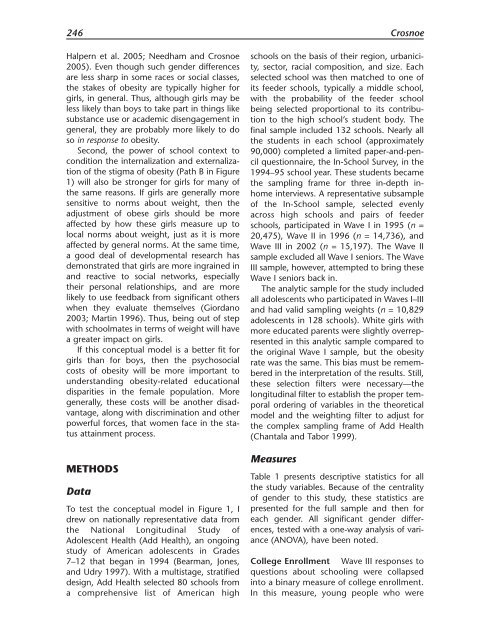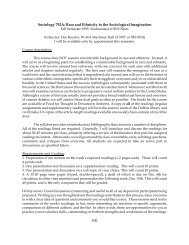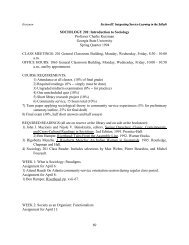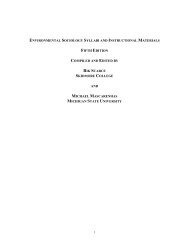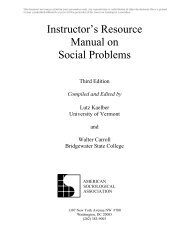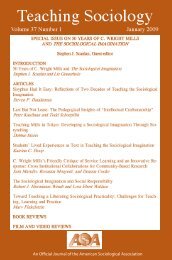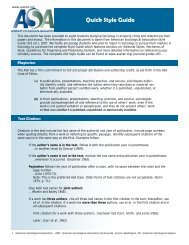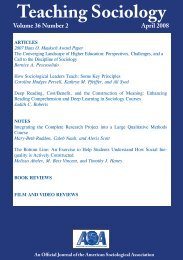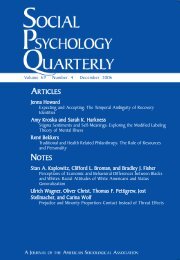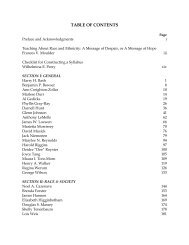SOCIOLOGY EDUCATION - American Sociological Association
SOCIOLOGY EDUCATION - American Sociological Association
SOCIOLOGY EDUCATION - American Sociological Association
Create successful ePaper yourself
Turn your PDF publications into a flip-book with our unique Google optimized e-Paper software.
246 Crosnoe<br />
Halpern et al. 2005; Needham and Crosnoe<br />
2005). Even though such gender differences<br />
are less sharp in some races or social classes,<br />
the stakes of obesity are typically higher for<br />
girls, in general. Thus, although girls may be<br />
less likely than boys to take part in things like<br />
substance use or academic disengagement in<br />
general, they are probably more likely to do<br />
so in response to obesity.<br />
Second, the power of school context to<br />
condition the internalization and externalization<br />
of the stigma of obesity (Path B in Figure<br />
1) will also be stronger for girls for many of<br />
the same reasons. If girls are generally more<br />
sensitive to norms about weight, then the<br />
adjustment of obese girls should be more<br />
affected by how these girls measure up to<br />
local norms about weight, just as it is more<br />
affected by general norms. At the same time,<br />
a good deal of developmental research has<br />
demonstrated that girls are more ingrained in<br />
and reactive to social networks, especially<br />
their personal relationships, and are more<br />
likely to use feedback from significant others<br />
when they evaluate themselves (Giordano<br />
2003; Martin 1996). Thus, being out of step<br />
with schoolmates in terms of weight will have<br />
a greater impact on girls.<br />
If this conceptual model is a better fit for<br />
girls than for boys, then the psychosocial<br />
costs of obesity will be more important to<br />
understanding obesity-related educational<br />
disparities in the female population. More<br />
generally, these costs will be another disadvantage,<br />
along with discrimination and other<br />
powerful forces, that women face in the status<br />
attainment process.<br />
METHODS<br />
Data<br />
To test the conceptual model in Figure 1, I<br />
drew on nationally representative data from<br />
the National Longitudinal Study of<br />
Adolescent Health (Add Health), an ongoing<br />
study of <strong>American</strong> adolescents in Grades<br />
7–12 that began in 1994 (Bearman, Jones,<br />
and Udry 1997). With a multistage, stratified<br />
design, Add Health selected 80 schools from<br />
a comprehensive list of <strong>American</strong> high<br />
schools on the basis of their region, urbanicity,<br />
sector, racial composition, and size. Each<br />
selected school was then matched to one of<br />
its feeder schools, typically a middle school,<br />
with the probability of the feeder school<br />
being selected proportional to its contribution<br />
to the high school’s student body. The<br />
final sample included 132 schools. Nearly all<br />
the students in each school (approximately<br />
90,000) completed a limited paper-and-pencil<br />
questionnaire, the In-School Survey, in the<br />
1994–95 school year. These students became<br />
the sampling frame for three in-depth inhome<br />
interviews. A representative subsample<br />
of the In-School sample, selected evenly<br />
across high schools and pairs of feeder<br />
schools, participated in Wave I in 1995 (n =<br />
20,475), Wave II in 1996 (n = 14,736), and<br />
Wave III in 2002 (n = 15,197). The Wave II<br />
sample excluded all Wave I seniors. The Wave<br />
III sample, however, attempted to bring these<br />
Wave I seniors back in.<br />
The analytic sample for the study included<br />
all adolescents who participated in Waves I–III<br />
and had valid sampling weights (n = 10,829<br />
adolescents in 128 schools). White girls with<br />
more educated parents were slightly overrepresented<br />
in this analytic sample compared to<br />
the original Wave I sample, but the obesity<br />
rate was the same. This bias must be remembered<br />
in the interpretation of the results. Still,<br />
these selection filters were necessary—the<br />
longitudinal filter to establish the proper temporal<br />
ordering of variables in the theoretical<br />
model and the weighting filter to adjust for<br />
the complex sampling frame of Add Health<br />
(Chantala and Tabor 1999).<br />
Measures<br />
Table 1 presents descriptive statistics for all<br />
the study variables. Because of the centrality<br />
of gender to this study, these statistics are<br />
presented for the full sample and then for<br />
each gender. All significant gender differences,<br />
tested with a one-way analysis of variance<br />
(ANOVA), have been noted.<br />
College Enrollment Wave III responses to<br />
questions about schooling were collapsed<br />
into a binary measure of college enrollment.<br />
In this measure, young people who were


